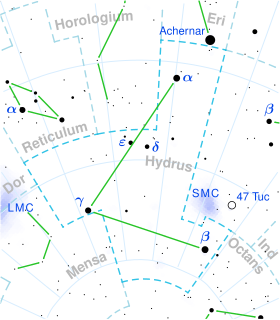델타 하이드리
Delta Hydri| 관측 데이터 에폭 J2000 이쿼녹스 J2000 | |
|---|---|
| 별자리 | 하이드러스 |
| 우측 상승 | 02h 21m 44.94286s[1] |
| 탈위임 | −68° 39′ 33.9038″[1] |
| 겉보기 크기 (V) | 4.09[2] |
| 특성. | |
| 스펙트럼형 | A2 V[3] |
| U-B색지수 | +0.05[2] |
| B-V색지수 | +0.03[2] |
| 아스트로메트리 | |
| 방사 속도 (Rv) | +6.00km[4]/s |
| 고유 운동 (μ) | RA: -49.95[1]mas/yr Dec.: +2.48마스[1]/yr |
| 시차 (π) | 23.35 ± 0.34[1] 마스 |
| 거리 | 140 ± 2 리 (42.8 ± 0.6 pc) |
| 절대치수 (MV) | 0.92[3] |
| 세부 사항 | |
| 미사 | 2.25[5] M☉ |
| 반지름 | 2.3[5] R☉ |
| 루미도 | 39.52[3] L☉ |
| 표면 중력 (log g) | 3.98[6] cgs |
| 온도 | 9,880±336[6] K |
| 금속성 [Fe/H] | +0.12[3] 덱스 |
| 회전 속도 (v sin i) | 시속 162km[6] |
| 나이 | 209[6] Merr |
| 기타 지정 | |
| 데이터베이스 참조 | |
| 심바드 | 자료 |
Δ 하이드리에서 라틴어로 표기된 델타 하이드리는 하이드러스 남쪽 별자리에 있는 단일 [7]백색 별이다. 겉으로 보이는 시력 4.09로 육안으로 희미하게 보일 정도로 밝다.[2] 연간 시차 변화 23.35 mas에 근거한 이 별까지의 거리는 약 140광년이다.[1] 그것은 방사상 속도 +6 km/s로 태양으로부터 멀어지고 있다.[4]
이것은 A2[3] V의 별 분류가 A2 V인 일반 A형 주계열성으로 약 2억 9천만년 된 것으로 회전율이 높아 162km/s의 예상 회전속도를 보인다.[6] 이것은 이 별에게 극성 반지름보다 7% 더 큰 적도 불룩을 가진 지운 모양을 주고 있다.[8] 이 별은 태양의 2.25배, 태양의 반지름의 2.3배의 질량을 가지고 있다.[5] 그것은 약 9.880의 유효 온도로 태양의 광권으로부터 태양의 39[3].5배의 광도를 방출하고 있다.[6] 델타 하이드리는 적외선 초과 여부를 확인했으나 발견되지 않았다.[7]
참조
- ^ a b c d e f Van Leeuwen, F. (2007). "Validation of the new Hipparcos reduction". Astronomy and Astrophysics. 474 (2): 653–664. arXiv:0708.1752. Bibcode:2007A&A...474..653V. doi:10.1051/0004-6361:20078357. S2CID 18759600. Vizier 카탈로그 항목
- ^ a b c d Ducati, J. R. (2002). "VizieR Online Data Catalog: Catalogue of Stellar Photometry in Johnson's 11-color system". CDS/ADC Collection of Electronic Catalogues. 2237. Bibcode:2002yCat.2237....0D.
- ^ a b c d e f Anderson, E.; Francis, Ch. (2012). "XHIP: An extended hipparcos compilation". Astronomy Letters. 38 (5): 331. arXiv:1108.4971. Bibcode:2012AstL...38..331A. doi:10.1134/S1063773712050015. S2CID 119257644. Vizier 카탈로그 항목
- ^ a b Kharchenko, N.V.; Scholz, R.-D.; Piskunov, A.E.; Röser, S.; Schilbach, E. (2007). "Astrophysical supplements to the ASCC-2.5: Ia. Radial velocities of ∼55000 stars and mean radial velocities of 516 Galactic open clusters and associations". Astronomische Nachrichten. 328 (9): 889. arXiv:0705.0878. Bibcode:2007AN....328..889K. doi:10.1002/asna.200710776. S2CID 119323941.
- ^ a b c Allende Prieto, C.; Lambert, D. L. (1999). "Fundamental parameters of nearby stars from the comparison with evolutionary calculations: Masses, radii and effective temperatures". Astronomy and Astrophysics. 352: 555–562. arXiv:astro-ph/9911002. Bibcode:1999A&A...352..555A. Vizier 카탈로그 항목
- ^ a b c d e f David, Trevor J.; Hillenbrand, Lynne A. (2015). "The Ages of Early-Type Stars: Strömgren Photometric Methods Calibrated, Validated, Tested, and Applied to Hosts and Prospective Hosts of Directly Imaged Exoplanets". The Astrophysical Journal. 804 (2): 146. arXiv:1501.03154. Bibcode:2015ApJ...804..146D. doi:10.1088/0004-637X/804/2/146. S2CID 33401607. Vizier 카탈로그 항목
- ^ a b Rodriguez, David R.; et al. (May 2015), "Stellar multiplicity and debris discs: an unbiased sample", Monthly Notices of the Royal Astronomical Society, 449 (3): 3160–3170, arXiv:1503.01320, Bibcode:2015MNRAS.449.3160R, doi:10.1093/mnras/stv483, S2CID 119237891.
- ^ van Belle, Gerard T. (March 2012), "Interferometric observations of rapidly rotating stars", The Astronomy and Astrophysics Review, 20 (1): 51, arXiv:1204.2572, Bibcode:2012A&ARv..20...51V, doi:10.1007/s00159-012-0051-2, S2CID 119273474.



